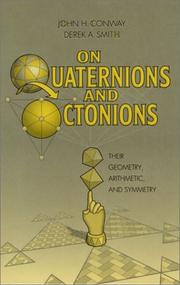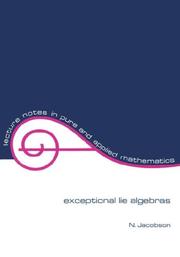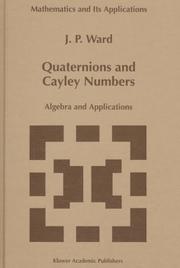| Listing 1 - 4 of 4 |
Sort by
|

ISBN: 1568811349 Year: 2003 Publisher: Natick, Mass. Peters
Abstract | Keywords | Export | Availability | Bookmark
 Loading...
Loading...Choose an application
- Reference Manager
- EndNote
- RefWorks (Direct export to RefWorks)
Group theory --- Quaternios. --- Álgebra. --- Quaternions. --- Cayley numbers. --- Quaternions --- 511.147 --- Complex numbers. Imaginaries --- 511.147 Complex numbers. Imaginaries --- Álgebra. --- Cayley numbers --- Algebra, Universal --- Algebraic fields --- Curves --- Surfaces --- Numbers, Complex --- Vector analysis --- Cayley numbers (Algebra) --- Octonions --- Nombres hypercomplexes --- Geometrie

ISBN: 0824713265 Year: 1971 Publisher: New York
Abstract | Keywords | Export | Availability | Bookmark
 Loading...
Loading...Choose an application
- Reference Manager
- EndNote
- RefWorks (Direct export to RefWorks)
Ordered algebraic structures --- Lie algebras. --- Exceptional Lie algebras. --- Nombres hypercomplexes --- Octonions --- Cayley numbers (Algebra) --- Galois cohomology --- Cohomologie galoisienne.

ISBN: 3540663371 3642085636 3662126222 9783540663379 Year: 2000 Publisher: Berlin: Springer,
Abstract | Keywords | Export | Availability | Bookmark
 Loading...
Loading...Choose an application
- Reference Manager
- EndNote
- RefWorks (Direct export to RefWorks)
The 1963 Göttingen notes of T. A. Springer are well-known in the field but have been unavailable for some time. This book is a translation of those notes, completely updated and revised. The part of the book dealing with the algebraic structures is on a fairly elementary level, presupposing basic results from algebra. In the group-theoretical part use is made of some results from the theory of linear algebraic groups. The book will be useful to mathematicians interested in octonion algebras and Albert algebras, or in exceptional groups. It is suitable for use in a graduate course in algebra.
Group theory --- Cayley numbers (Algebra) --- Jordan algebras. --- Alternative rings --- Linear algebraic groups. --- Cayley, Octaves de --- Jordan, Algèbres de --- Anneaux alternatifs --- Groupes linéaires algébriques --- Cayley numbers --- Jordan algebras --- Linear algebraic groups --- Alternative rings. --- Cayley numbers. --- Jordan, Algèbres de --- Groupes linéaires algébriques --- Commutative algebra. --- Commutative rings. --- Group theory. --- Commutative Rings and Algebras. --- Group Theory and Generalizations. --- Groups, Theory of --- Substitutions (Mathematics) --- Algebra --- Rings (Algebra)

ISBN: 0792345134 9401064342 9401157685 Year: 1997 Publisher: Dordrecht : Kluwer,
Abstract | Keywords | Export | Availability | Bookmark
 Loading...
Loading...Choose an application
- Reference Manager
- EndNote
- RefWorks (Direct export to RefWorks)
In essence, this text is written as a challenge to others, to discover significant uses for Cayley number algebra in physics. I freely admit that though the reading of some sections would benefit from previous experience of certain topics in physics - particularly relativity and electromagnetism - generally the mathematics is not sophisticated. In fact, the mathematically sophisticated reader, may well find that in many places, the rather deliberate progress too slow for their liking. This text had its origin in a 90-minute lecture on complex numbers given by the author to prospective university students in 1994. In my attempt to develop a novel approach to the subject matter I looked at complex numbers from an entirely geometric perspective and, no doubt in line with innumerable other mathematicians, re-traced steps first taken by Hamilton and others in the early years of the nineteenth century. I even enquired into the possibility of using an alternative multiplication rule for complex numbers (in which argzlz2 = argzl- argz2) other than the one which is normally accepted (argzlz2 = argzl + argz2). Of course, my alternative was rejected because it didn't lead to a 'product' which had properties that we now accept as fundamental (i. e.
Algebra --- 511.6 --- Cayley numbers --- Quaternions --- Algebra, Universal --- Algebraic fields --- Curves --- Surfaces --- Numbers, Complex --- Vector analysis --- Algebraic number fields --- Quaternions. --- Cayley numbers. --- 511.6 Algebraic number fields --- Associative rings. --- Rings (Algebra). --- Nonassociative rings. --- Matrix theory. --- Algebra. --- Mathematical physics. --- Applied mathematics. --- Engineering mathematics. --- Associative Rings and Algebras. --- Non-associative Rings and Algebras. --- Linear and Multilinear Algebras, Matrix Theory. --- Theoretical, Mathematical and Computational Physics. --- Applications of Mathematics. --- Engineering --- Engineering analysis --- Mathematical analysis --- Physical mathematics --- Physics --- Mathematics --- Rings (Algebra) --- Algebraic rings --- Ring theory
| Listing 1 - 4 of 4 |
Sort by
|

 Search
Search Feedback
Feedback About UniCat
About UniCat  Help
Help News
News